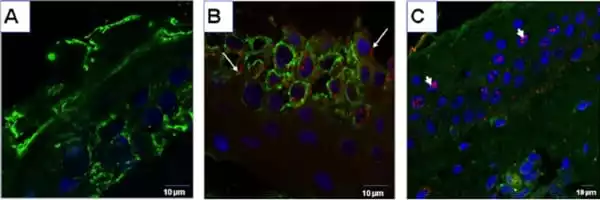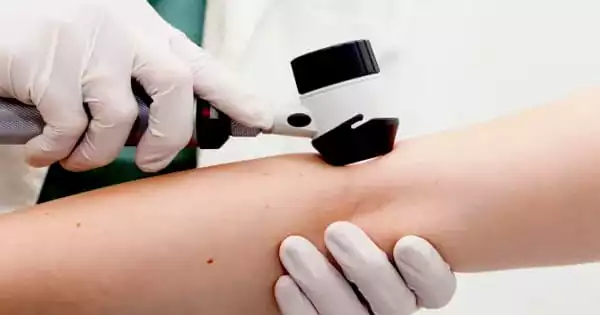Patients suspected of having Parkinson’s disease can now have their diagnosis confirmed with a simple skin test accessible at Boca Raton’s Marcus Neuroscience Institute. The test detects aberrant alpha-synuclein proteins in epidermal nerve fibers, which are connected to Parkinson’s disease and a number of other movement disorders, according to researchers.
According to researchers, the accumulation of the biomarker p-syn in the skin separates patients with Parkinson’s disease from those with symptoms of parkinsonism caused by other neurodegenerative conditions.
Parkinson’s disease (PD) is currently diagnosed using consensus clinical criteria. A new study published in the Journal of Parkinson’s Disease discovered that the presence of neuronal deposits of the biomarker phosphorylated alpha-synuclein (p-syn) in the brain and skin of patients with Parkinson’s disease distinguishes them from individuals with symptoms of parkinsonism caused by tau accumulation. This advancement may aid in the early detection and differential diagnosis of Parkinson’s disease among the numerous parkinsonism subtypes.
The primary parkinsonian symptoms are shared with various synucleinopathies as well as atypical parkinsonism, such as progressive supranuclear palsy (PSP) and corticobasal syndrome (CBS), both of which are caused by tau protein buildup. Despite clinical similarities with Parkinson’s disease, PSP is distinguished by 4-repeat tau deposits, primarily in the basal ganglia, brainstem, and cerebellum, whereas CBS is a clinical syndrome with a heterogeneous underlying neuropathology, characterized primarily by tauopathies but also by synucleinopathies.
To the best of our knowledge, this is the largest study comparing in vivo the peripheral deposition of misfolded alpha-synuclein in Parkinson’s disease and PSP/CBS cases. We demonstrated that the existence of skin p-syn deposits accurately differentiates patients with Parkinson’s disease from those with atypical parkinsonism.
Dr. Giannoccaro
“The goal of research in Parkinson’s disease and other neurodegenerative disorders is to identify medicines that can halt and, ideally, prevent the accumulation of pathogenic proteins that cause the various symptoms. Prof. Rocco Liguori and Dr. Vincenzo Donadio’s lab has spent the last decade searching for reliable biomarkers of Parkinson’s disease and related disorders in order to achieve an accurate and early diagnosis” Maria Pia Giannoccaro, PhD, Department of Biomedical and Neuromotor Sciences, University of Bologna and IRCCS Istituto delle Scienze Neurologiche di Bologna, Bologna, Italy, explained the study’s corresponding author.
“This study arose from the same endeavor. Our goal was to determine if we could distinguish Parkinson’s disease from two potential mimics, PSP and CBS, and to look into the possibility of employing this approach to help with clinical diagnosis “Dr. Giannoccaro went on.
From May 2014 to April 2017, the researchers recruited 26 patients with Parkinson’s disease, 26 patients with PSP (18) or CBS (8), and 26 healthy people. To analyze p-syn deposits in skin nerves, all participants received skin biopsy in three locations: the leg, the thigh, and the cervical area. They discovered that all of the PSP/CBS patients, with the exception of two, had no skin p-syn deposits, as did all of the healthy people. In contrast, all Parkinson’s disease patients had p-syn deposition.

The researchers were taken aback when they discovered p-syn skin deposits in two patients with PSP and CBS, respectively. One hypothesis is that these two individuals were misdiagnosed; nonetheless, clinical and MRI evidence corroborated the diagnosis. Another intriguing idea is that some people have a mixed pathology, meaning they have numerous neurodegenerative illnesses at the same time. Both patients displayed certain aberrant traits more typical of Parkinson’s disease, which could indicate an atypical synucleinopathy presentation.
“To the best of our knowledge, this is the largest study comparing in vivo the peripheral deposition of misfolded alpha-synuclein in Parkinson’s disease and PSP/CBS cases,” Dr. Giannoccaro said. “We demonstrated that the existence of skin p-syn deposits accurately differentiates patients with Parkinson’s disease from those with atypical parkinsonism.” Because the treatment and prognosis of PD, PSP, and CBS varies, early distinction and precise in vivo diagnosis are critical for optimal clinical management and patient care.
The researchers urge that bigger patient samples be used in future studies to validate these findings. Furthermore, in the near future, it may be significant for patient recruitment in clinical studies of possible disease-modifying medications.
Parkinson’s disease (PD) is a slowly progressive disorder that affects movement, muscular function, and balance. It is the second most common age-related neurodegenerative condition, affecting roughly 3% of the population by the age of 65 and up to 5% of people over the age of 85.
Dr. Husain claims that, in addition to its accuracy, the Syn-One Test has a significant advantage in that the results are available in just three weeks. “For individuals suspected of having Parkinson’s disease, every week spent waiting for confirmation merely delays our capacity to assist them control their disease by another week,” she explains. “We need to confirm our diagnosis as quickly as possible.”
A more complex test, the Dopamine Transporter Scan (DaTscan), allows specialists to determine whether your body is producing enough dopamine. According to Dr. Husain, it has also proven to be highly accurate in verifying Parkinson’s disease diagnoses, but the findings sometimes take months.














